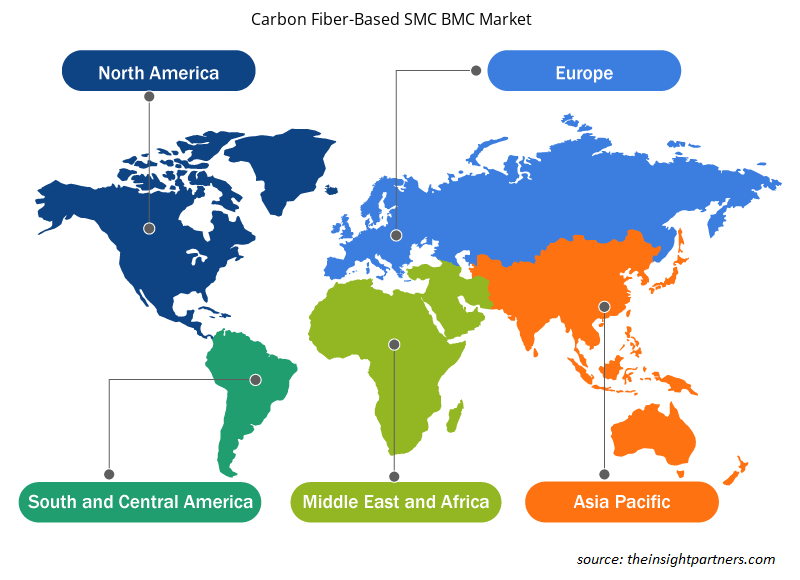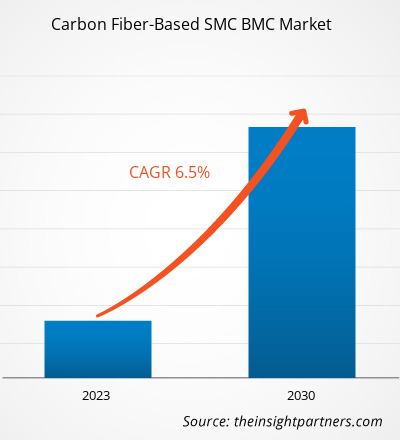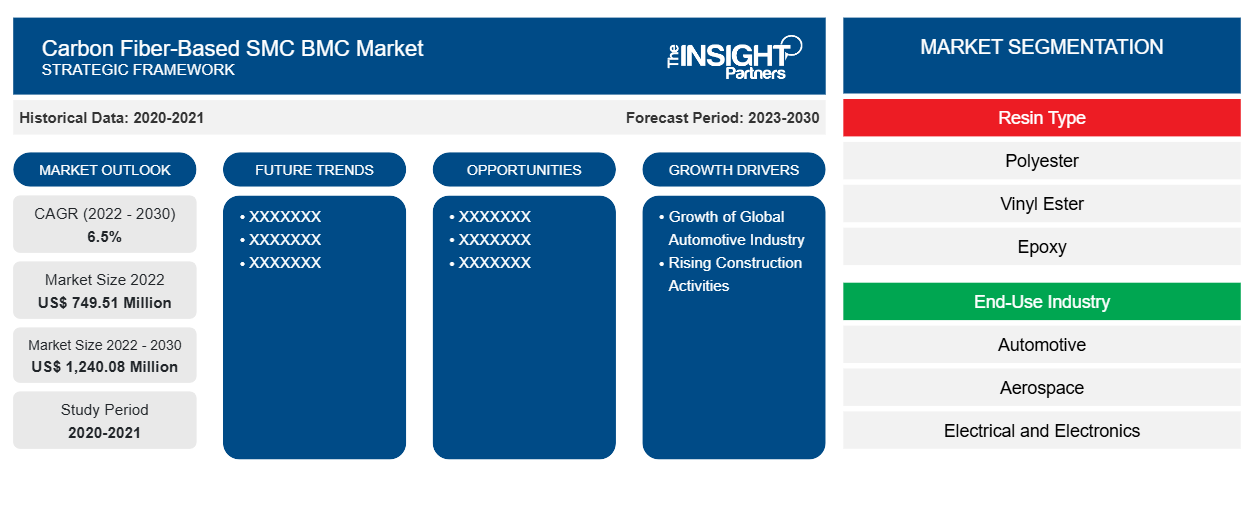[Forschungsbericht] Der Markt für kohlenstofffaserbasiertes SMC (BMC) hatte im Jahr 2022 einen Wert von 749,51 Millionen US-Dollar und soll bis 2030 1.240,08 Millionen US-Dollar erreichen; von 2022 bis 2030 wird mit einer durchschnittlichen jährlichen Wachstumsrate von 6,5 % gerechnet.
MARKTANALYSE
BMC auf Kohlenstofffaserbasis besteht aus kurzen Kohlenstofffasern , Füllstoffen und Harzsystemen, die zu Massenmaterial geformt werden. Es wird in Anwendungen eingesetzt, bei denen hohe Leistung und Maßgenauigkeit erforderlich sind. Der Ersatz von Metallkomponenten durch leichtes BMC und SMC auf Kohlenstofffaserbasis reduziert das Fahrzeuggewicht und bietet den zusätzlichen Vorteil der Chemikalien- und Feuerbeständigkeit. Darüber hinaus veranlassen zunehmende Nachhaltigkeitsinitiativen auf der ganzen Welt und strenge staatliche Vorschriften die Hersteller, SMC und BMC zu recyceln. Das Recycling von SMC und BMC auf Kohlenstofffaserbasis wird durch mechanisches Zerkleinern und Mahlen erreicht.
WACHSTUMSTREIBER UND HERAUSFORDERUNGEN
Die wachsende Automobilindustrie und die steigende Nachfrage nach leichten und langlebigen Materialien treiben das Wachstum des Marktes für kohlenstofffaserbasierte SMC-BMC voran . SMC und BMC auf Kohlenstofffaserbasis sind leicht und bieten Haltbarkeit, Designflexibilität, Toleranz gegenüber Temperaturschwankungen und chemische Beständigkeit. Sie haben verschiedene Anwendungen wie Karosserieteile, Strukturkomponenten und Isolierkomponenten. Die Nachfrage nach SMC und BMC für die Automobilproduktion ist gestiegen, da der Schwerpunkt auf der Reduzierung des Fahrzeuggewichts und der Verbesserung der Kraftstoffeffizienz liegt. Der Anstieg von Elektro- und Hybridfahrzeugen hat die Nachfrage nach leichten Materialien für die Isolierung elektrischer Komponenten weiter gesteigert. Somit treibt die wachsende Automobilindustrie die Nachfrage nach Automobilkomponenten an und fördert in der Folge das Wachstum des Marktes für kohlenstofffaserbasierte SMC-BMC. Die Verfügbarkeit von Ersatzprodukten für kohlenstofffaserbasierte SMC-BMC stellt eine Herausforderung für den Markt für kohlenstofffaserbasierte SMC-BMC dar. Glasfaserbasierte SMC- und BMC-Produkte, Aluminiumlegierungen, Thermoplaste, Naturfaserverbundstoffe, thermoplastische Verbundstoffe und Metallmatrixverbundstoffe gehören zu den Ersatzprodukten für kohlenstofffaserbasierte SMC- und BMC-Produkte. Glasfaserbasiertes SMC und BMC haben die gleichen Eigenschaften wie kohlenstofffaserbasiertes SMC und BMC. Sie sind jedoch kostengünstige Lösungen. Aluminiumlegierungen werden aufgrund ihrer hohen Festigkeit und Korrosionsbeständigkeit in der Automobil- und Luftfahrtindustrie verwendet. Daher hemmt die Verfügbarkeit von Ersatzstoffen das Wachstum des Marktes für kohlenstofffaserbasiertes SMC und BMC.
Passen Sie diesen Bericht Ihren Anforderungen an
Sie erhalten kostenlos individuelle Anpassungen an jedem Bericht, einschließlich Teilen dieses Berichts oder einer Analyse auf Länderebene, eines Excel-Datenpakets sowie tolle Angebote und Rabatte für Start-ups und Universitäten.
-
Holen Sie sich die wichtigsten Markttrends aus diesem Bericht.Dieses KOSTENLOSE Beispiel umfasst eine Datenanalyse von Markttrends bis hin zu Schätzungen und Prognosen.
SEGMENTIERUNG UND UMFANG DES BERICHTS
Die „Globale Marktanalyse für kohlenstofffaserbasiertes SMC BMC bis 2030“ ist eine spezialisierte und eingehende Studie mit einem starken Fokus auf globale Markttrends und Wachstumschancen. Der Bericht soll einen Überblick über den globalen Markt mit detaillierter Marktsegmentierung auf der Grundlage von Harztyp, Endverbrauchsbranche und Geografie geben. Der Bericht liefert wichtige Statistiken zum Verbrauch von kohlenstofffaserbasiertem SMC BMC auf der ganzen Welt sowie deren Nachfrage in wichtigen Regionen und Ländern. Darüber hinaus bietet der Bericht eine qualitative Bewertung verschiedener Faktoren, die die Marktleistung von kohlenstofffaserbasiertem SMC BMC in wichtigen Regionen und Ländern beeinflussen. Er enthält außerdem eine umfassende Analyse der führenden Akteure auf dem Markt für kohlenstofffaserbasiertes SMC BMC und ihrer wichtigsten strategischen Entwicklungen. Eine Analyse der Marktdynamik ist ebenfalls enthalten, um die wichtigsten Antriebsfaktoren, Markttrends und lukrativen Möglichkeiten zu identifizieren, die wiederum dazu beitragen würden, die wichtigsten Einnahmequellen zu identifizieren.
Die Ökosystemanalyse und Porters Fünf-Kräfte-Analyse bieten eine 360-Grad-Ansicht des globalen Marktes für kohlenstofffaserbasiertes SMC (BMC), die dabei hilft, die gesamte Lieferkette und die verschiedenen Faktoren zu verstehen, die das Marktwachstum beeinflussen.
SEGMENTANALYSE
Der globale Markt für kohlenstofffaserbasiertes SMC BMC ist nach Harztyp und Endverbrauchsbranche segmentiert. Basierend auf dem Harztyp ist der Markt für kohlenstofffaserbasiertes SMC BMC in Polyester, Vinylester, Epoxid und andere segmentiert. Basierend auf der Endverbrauchsbranche ist der Markt in Automobil, Luft- und Raumfahrt, Elektrik und Elektronik, Bauwesen und Konstruktion und andere segmentiert. Basierend auf dem Harztyp machte das Polyestersegment im Jahr 2022 einen erheblichen Anteil des Marktes für kohlenstofffaserbasiertes SMC BMC aus. Verarbeitungsvorteile von Polyester wie niedrige Viskosität, schnelle Aushärtung und verbesserte Verarbeitungsrobustheit tragen dazu bei, die Zykluszeiten erheblich zu verkürzen und führen letztendlich zu einer höheren Produktivität. Vinylesterharze gelten als beliebter Harztyp, der bei der BMC- und SMC-Produktion verwendet wird. Vinylesterharze besitzen mehrere charakteristische Merkmale wie niedrige Viskosität, mechanische Eigenschaften, niedrige Verarbeitungskosten und die Fähigkeit, bei Raumtemperatur auszuhärten. Polyetherketonketon (PEKK), Polyetheretherketon (PEEK), Polyphenylensulfid (PPS) und Polyetherimid (PEI) gehören zu den anderen Harztypen, die zur Herstellung von SMC-BMC-Produkten auf Kohlenstofffaserbasis verwendet werden. Basierend auf der Endverbrauchsindustrie hatte das Automobilsegment im Jahr 2022 einen erheblichen Anteil. Die Automobilindustrie hat die Herstellung von Leichtbauteilen betont und damit Metalle und Legierungsmaterialien ersetzt. Die BMC-Formulierung hält hohen Temperaturen und widrigen Umgebungsbedingungen stand und ist daher eine ideale Wahl für Motorkomponenten wie Zündsysteme und Sensoren in der Luft- und Raumfahrtindustrie. SMC und BMC werden im Allgemeinen zur Herstellung von elektrischen Gehäusen und Schränken verwendet. Diese Materialien sind außerdem so konzipiert, dass sie Eigenschaften wie Feuchtigkeitsbeständigkeit und Korrosionsbeständigkeit aufweisen und die Sicherheitsstandards für elektrische Geräte erfüllen. SMC und BMC bieten hohe Festigkeit, Haltbarkeit und Toleranz gegenüber widrigen Umgebungsbedingungen. Fassadenelemente, einschließlich Zierleisten, Gesimse, architektonische Elemente und andere, werden aus SMC und BMC hergestellt, da sie Witterungsbeständigkeit und Gestaltungsflexibilität bieten.
REGIONALE ANALYSE
Der Bericht bietet einen detaillierten Überblick über den globalen Markt für kohlenstofffaserbasiertes SMC BMC in Bezug auf fünf Hauptregionen – Nordamerika, Europa, Asien-Pazifik (APAC), Naher Osten und Afrika (MEA) sowie Süd- und Mittelamerika. Der asiatisch-pazifische Raum hatte einen erheblichen Anteil am globalen Markt für kohlenstofffaserbasiertes SMC BMC und wurde im Jahr 2022 auf über 350 Millionen US-Dollar geschätzt. Der asiatisch-pazifische Raum ist ein Zentrum für die Automobilherstellung mit einer großen Präsenz internationaler und inländischer Akteure in der Region. Der Bericht der Internationalen Organisation der Kraftfahrzeughersteller besagt, dass verschiedene Länder im asiatisch-pazifischen Raum im Jahr 2021 etwa 46,73 Millionen Kraftfahrzeuge produzierten. Bei der Herstellung von Autos, Lastwagen, Bussen und landwirtschaftlichen Fahrzeugen bieten SMC- und BMC-Produkte Vorteile wie Teilekonsolidierung, Korrosionsbeständigkeit, geringes Gewicht und andere. Die Vorteile von SMC- und BMC-Produkten, gepaart mit der wachsenden Automobilindustrie, treiben das Marktwachstum im asiatisch-pazifischen Raum voran. Der europäische Markt für kohlenstofffaserbasiertes SMC BMC wird voraussichtlich bis 2030 mehr als 250 Millionen US-Dollar erreichen. Die Automobilindustrie ist eine wichtige Branche in Europa, da sie erheblich zum BIP vieler europäischer Länder beiträgt, darunter Deutschland, Großbritannien und Italien. Laut dem Bericht der Europäischen Kommission entspricht der von der Branche in Europa im Jahr 2021 erwirtschaftete Umsatz 7 % des gesamten BIP der Region. Der nordamerikanische Markt für kohlenstofffaserbasiertes SMC BMC wird voraussichtlich von 2022 bis 2030 eine durchschnittliche jährliche Wachstumsrate von ~6 % verzeichnen. Nordamerika bietet den Akteuren von kohlenstofffaserbasiertem SMC BMC aufgrund der wachsenden Endverbrauchsbranchen wie der Automobil-, Luft- und Raumfahrt- sowie der Elektro- und Elektronikindustrie umfassende Wachstumschancen.
Branchenentwicklungen und zukünftige Chancen
Nachfolgend sind verschiedene Initiativen der wichtigsten Akteure auf dem Markt für kohlenstofffaserbasiertes SMC (BMC) aufgeführt:
- Im Jahr 2023 entwickelte Engenuity einen neuen Ansatz für SMC, Failure in Random Material Architectures (FiRMA). Dabei wird eine Vorhersagetechnik verwendet, die die Materialeigenschaften genau widerspiegelt und den Leistungsbereich bestimmt, den ein SMC-Teil oder eine SMC-Struktur aufweisen wird.
- Im Jahr 2021 entwickelten AOC, Zoltek und Astar neuartige CF-SMC für Hochleistungsautoteile im industriellen Maßstab. AOC AG (Schaffhausen, Schweiz) hat zusammen mit Astar (Biskaya, Spanien) im Rahmen des von der britischen Regierung finanzierten Forschungsprojekts TUCANA eine neue Plattenformmasse auf Basis der Daron-Polyurethan-Hybridtechnologie entwickelt.
Regionale Einblicke in den Markt für kohlenstofffaserbasiertes SMC (BMC)
Die regionalen Trends und Faktoren, die den Markt für kohlenstofffaserbasierte SMC-BMCs während des Prognosezeitraums beeinflussen, wurden von den Analysten von Insight Partners ausführlich erläutert. In diesem Abschnitt werden auch die Marktsegmente und die Geografie für kohlenstofffaserbasierte SMC-BMCs in Nordamerika, Europa, im asiatisch-pazifischen Raum, im Nahen Osten und Afrika sowie in Süd- und Mittelamerika erörtert.

- Erhalten Sie regionale Daten zum SMC-BMC-Markt auf Kohlenstofffaserbasis
Umfang des Marktberichts über kohlenstofffaserbasiertes SMC (BMC)
| Berichtsattribut | Details |
|---|---|
| Marktgröße im Jahr 2022 | 749,51 Millionen US-Dollar |
| Marktgröße bis 2030 | 1.240,08 Millionen US-Dollar |
| Globale CAGR (2022 - 2030) | 6,5 % |
| Historische Daten | 2020-2021 |
| Prognosezeitraum | 2023–2030 |
| Abgedeckte Segmente |
Nach Harztyp
|
| Abgedeckte Regionen und Länder |
Nordamerika
|
| Marktführer und wichtige Unternehmensprofile |
|
Marktteilnehmerdichte: Der Einfluss auf die Geschäftsdynamik
Der Markt für kohlenstofffaserbasierte SMC-BMCs wächst rasant, angetrieben durch die steigende Nachfrage der Endverbraucher aufgrund von Faktoren wie sich entwickelnden Verbraucherpräferenzen, technologischen Fortschritten und einem größeren Bewusstsein für die Vorteile des Produkts. Mit steigender Nachfrage erweitern Unternehmen ihr Angebot, entwickeln Innovationen, um die Bedürfnisse der Verbraucher zu erfüllen, und nutzen neue Trends, was das Marktwachstum weiter ankurbelt.
Die Marktteilnehmerdichte bezieht sich auf die Verteilung von Firmen oder Unternehmen, die in einem bestimmten Markt oder einer bestimmten Branche tätig sind. Sie gibt an, wie viele Wettbewerber (Marktteilnehmer) in einem bestimmten Marktraum im Verhältnis zu seiner Größe oder seinem gesamten Marktwert präsent sind.
Die wichtigsten Unternehmen auf dem SMC-BMC-Markt auf Kohlenstofffaserbasis sind:
- Teijin Carbon Europe GmbH
- Mitsubishi Chemical Corporation
- ASTAR SA
- Menzolit
- Polynt SpA
Haftungsausschluss : Die oben aufgeführten Unternehmen sind nicht in einer bestimmten Reihenfolge aufgeführt.

- Überblick über die wichtigsten Akteure auf dem Markt für kohlenstofffaserbasiertes SMC (BMC)
AUSWIRKUNGEN DER COVID-19-PANDEMIE/AUSWIRKUNGEN DES GEOPOLITISCHEN SZENARIOS/AUSWIRKUNGEN DER REZESSION
Branchen wie die Automobil-, Elektronik- und Luftfahrtindustrie sind die Hauptverbraucher von SMC BMC auf Kohlenstofffaserbasis. Im Jahr 2020 mussten diese Branchen ihre Betriebsabläufe aufgrund von Störungen in der Wertschöpfungskette aufgrund staatlicher Vorschriften und Handelsbeschränkungen verlangsamen. Darüber hinaus beeinträchtigten von verschiedenen Ländern verhängte Lockdowns im selben Jahr die Lagerbestände vieler Hersteller. Der Mangel an Arbeitskräften führte zu einer Verringerung der Produktion und des Vertriebs von SMC BMC auf Kohlenstofffaserbasis. Darüber hinaus verringerten staatliche Beschränkungen und andere COVID-19-bezogene Vorsichtsmaßnahmen die Betriebskapazitäten der Beteiligten an der Wertschöpfungskette des Marktes für SMC BMC auf Kohlenstofffaserbasis.
Ende 2021 begann sich der globale Markt für kohlenstofffaserbasiertes SMC BMC von den im Jahr 2020 erlittenen Verlusten zu erholen, da Endverbrauchsbranchen wie die Automobilindustrie, das Baugewerbe sowie die Elektro- und Elektronikindustrie wieder auflebten. Der Ausbau der Produktionskapazitäten in der Chemie- und Materialindustrie nach der COVID-19-Pandemie in vielen Regionen wie dem asiatisch-pazifischen Raum und Nordamerika dürfte in den kommenden Jahren lukrative Möglichkeiten für den Markt für kohlenstofffaserbasiertes SMC BMC schaffen.
WETTBEWERBSLANDSCHAFT UND SCHLÜSSELUNTERNEHMEN
Zu den wichtigsten Akteuren auf dem Markt für kohlenstofffaserbasiertes SMC (BMC) zählen Teijin Carbon Europe GmBH, Mitsubishi Chemical Corp, ASTAR SA, Menzolit, Polynt SpA, IDI Composite International, LyondellBasell Industries Holdings BV, Lattice Composites LLC, Toray Advanced Composites und YS ACC.
- Historische Analyse (2 Jahre), Basisjahr, Prognose (7 Jahre) mit CAGR
- PEST- und SWOT-Analyse
- Marktgröße Wert/Volumen – Global, Regional, Land
- Branchen- und Wettbewerbslandschaft
- Excel-Datensatz
Aktuelle Berichte
Erfahrungsberichte
Grund zum Kauf
- Fundierte Entscheidungsfindung
- Marktdynamik verstehen
- Wettbewerbsanalyse
- Kundeneinblicke
- Marktprognosen
- Risikominimierung
- Strategische Planung
- Investitionsbegründung
- Identifizierung neuer Märkte
- Verbesserung von Marketingstrategien
- Steigerung der Betriebseffizienz
- Anpassung an regulatorische Trends























 Kostenlose Probe anfordern für - Markt für SMC-BMC auf Kohlefaserbasis
Kostenlose Probe anfordern für - Markt für SMC-BMC auf Kohlefaserbasis